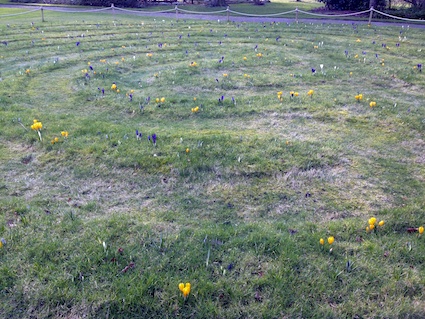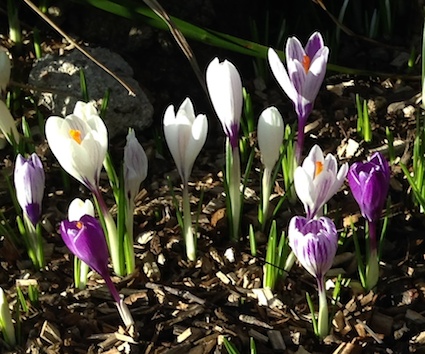When the crocus appears, it’s a positive indication that spring is on its way. Snowdrop is the lead flower in letting us know that winter’s days are numbered. But crocus is the follower that affirms the decision of snowdrop to rear its head above the snow. Suddenly all sorts of other plants start pushing up and growing. Every leader needs a faithful first follower and crocus does the job proudly.

At the Cruikshank Botanic Gardens one of the most exciting spring events is the crocus labyrinth coming into flower. Back in 2012, the garden staff planted over 4000 crocus on the rough mounds. No other bulbs are there, so it’s a subtle, temporary affair. A welcome sign of spring for visitors.

Labyrinths are all about controlled, reflective walking. You follow the path. It leads you through the labyrinth so that every part is walked upon. It’s an opportunity to listen to the sounds of spring, to think about the beauty of the surroundings and just be in the present.
Such situations lend themselves readily for the development of a metasaga. Many years ago, Helen Hulleat at Community Playthings commented about children and flowers:
“The more I immerse myself in Froebel’s ideas, the more I appreciate them and can’t resist passing them on. I love his image of the child as a flower: vulnerable, yet strong with the will to grow and thrive…
…Froebel’s comparison brings another thought to mind: You cannot force a daisy to become a rose, no matter how much fertilizer you apply. So let’s enjoy daisies as they are and support each child being the individual he or she is meant to be!“
When putting together information for this blog post, I was searching for a decent story to complement the Snowdrop Story. However none of the ones I read online really hit the mark. The name crocus is believed to have its roots in Greek mythology. It is derived from Krokos, who was a friend of Hermes. One day when the two of them were playing with a discus, Krokos got hit on the head by the discus and died. To express his sorrow and grief, Hermes transformed the drops of blood from the head wound into crocus flowers where they left their mark on the ground. The bright beauty and variety of crocus flowers are a visual reminder of friendship, love and the emerging warmth of spring.

The Rotary International have a Crocus Campaign. It began in 2011 when RIBI member Lynn Mitchell picked a purple crocus from her garden to wear as a buttonhole to a Rotary Day event. At the time, Rotarians in Britain and Ireland were planting millions of purple crocus bulbs to support the End Polio Now Campaign and fund raise for this charity. Once again the crocus is a symbol of care and concern for others.
So when you next go for a walk, with or without children, enjoy the crocuses and the thoughts which come to mind. If you are thinking about the value of a labyrinth within a school grounds, then this blog post about the Coombes School approach may help. For temporary experiments with labyrinths in a class using ropes and chalk, then have a look here.
Finally if you are looking for a simple song about crocus, then have a look at this one – the lyrics are in the blurb below the video and there’s actions too!
This blog post was originally published in March 2014.




















Hi j
I enjoyed the story of croci – perfectly timed..
P